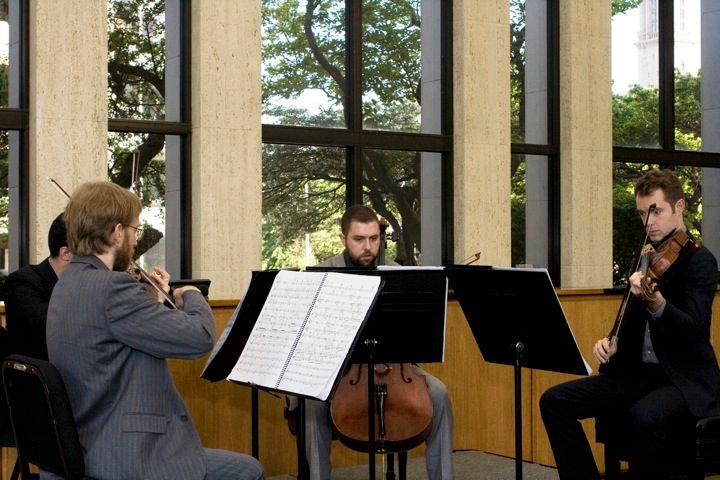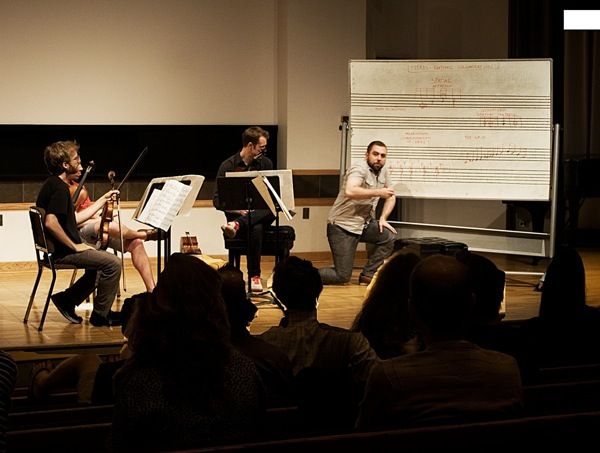June in Buffalo has been an international festival since its inception, attracting composers, performers, and other artists from around the world. Its aesthetic has always been a broad one, where one is likely to hear American experimentalists programmed alongside the European avant garde. It is for this reason, that Josh Levine makes a perfect addition to the JiB faculty, as he is an American composer with significant international ties, and a broadly cosmopolitan aesthetic.
 |
| Josh Levine |
While he was born in Oregon, Levine originally trained as a classical guitarist in Basel, Switzerland. He continued his musical studies in the same country as he switched to composition, studying with Balz Trümpy. He later studied at the Paris Conservatory with Guy Reibel, and worked at IRCAM, later returning to the US to earn his PhD from UC San Diego, where he studied principally with Brian Ferneyhough. Since then, his music has been internationally recognized and has received several awards, including First Prize and a Euphonie d'Or at the Bourges International Electroacoustic Music Competition. His works have been commissioned by widely-recognized soloists including Aiyun Huang, Marcus Weiss, and Jürg Wyttenbach, as well as ensembles such as the soundSCAPE Trio, Calliope Duo, Ensemble Contrechamps, and Les Solistes de l’Ensemble Intercontemporain. He currently serves as Assistant Professor of Composition at Oberlin.
For Levine, music is a locus where the unity of imagination and memory can be found.
The musical work is, for me, a site where the irrational and the rational, the sensual and the conceptual, and, most basically, sound and silence, spar and dance and transcend their seeming dichotomies. Through ever-evolving interpretations of recurring musical materials, I explore the unity of memory and imagination—remembering as an act of imagining, and imagining as an act of remembering. My composing is inspired by movement and the contemplation of change, whether in the physical world or in the psyche.
Despite the abstractness of such conceptual imagery, Levine's music is dynamic and rooted in the concreteness of the physical gesture. "The physicality of musical performance and our emotional identification as listeners with its energy, gestures, and implicit drama are among its further driving forces." His early work in the field of electroacoustic music led to an interest in temporal fluidity and harmonic nuance, as well as an attention to detail that seeks to bring "a richer resonance to every moment." Such temporal and timbral examination can be heard in Levine's recent acousmatic piece, Oneirograph, which uses violin samples as its source material, but pulls open these sounds, finding vast resonant soundscapes within. The piece's title refers to an instrument for measuring dreams—dreams, of course, being another site in which the divisions between memory and imagination become suspect.
This year's festival will see the performances of three of Levine's pieces. The Slee Sinfonietta will present two of these. The first, Four places, many more times (2011), is a percussion quartet which revolves around twelve specially tuned metal pipes. Continuing Levine's interest in flexible perceptions of time, the composer describes the work as a series of "'sound objects' [which] shift and spin through space and different time zones in a kind of timbral kaleidoscope." The second, Former Selves, for solo guitar, ensemble, and electronics features JiB special guest Magnus Andersson. Approaching the idea of memory from a different angle, this work incorporates elements from several of the composer's earlier works, both as musical gestures articulated by the performers, as well as samples which are transformed by the electronics—even to the extent of incorporating recorded material from the piece's own 2007 premiere. Levine describes the relationship between the soloist and ensemble:
[The ensemble's music moves in largely homophonic blocks, like forms emerging from a void and receding again for no apparent reason. The guitar does not participate in their creation, but passes between them. As the homophony gradually unravels, the guitar in its turn begins to find openings into the ensemble, eventually (re)discovering there the full sound of its voice.
 |
| Levine, Former Selves (2007) |
As a guitarist himself, it is no surprise that Levine's work often emphasizes that instrument, and as a performer, Levine has performed with the likes of Ensemble Contrechamps, the Basel ISCM Ensemble, the Nouvel Ensemble Contemporain, SONOR, and members of the sfSoundgroup. He has recorded works by Mark Applebaum and Kristian Ireland on the Innova label.
As a dedicated teacher, Levine takes great joy in hearing the different approaches the students embrace in their own music. As he explains:
I love it when a student comes in to the lesson, puts the music on the music stand, and it may be—in fact, it's almost surely going to be—in a style, or with a particular aesthetic orientation that doesn't correspond to what I personally would write. But it's so fascinatingly done—it explores in such a beautiful way certain ideas, instrumental colors, or sounds that I've never quite explored in that way, and yet that I can empathize with and communicate with both through the score and through my personal relationship to them.
There is perhaps no better place for Levine to encounter the varied aesthetic orientations of young artists than at June in Buffalo, and we are excited for the composers who will learn from their dialogues with him, as they reckon with their own imaginations and memories.










